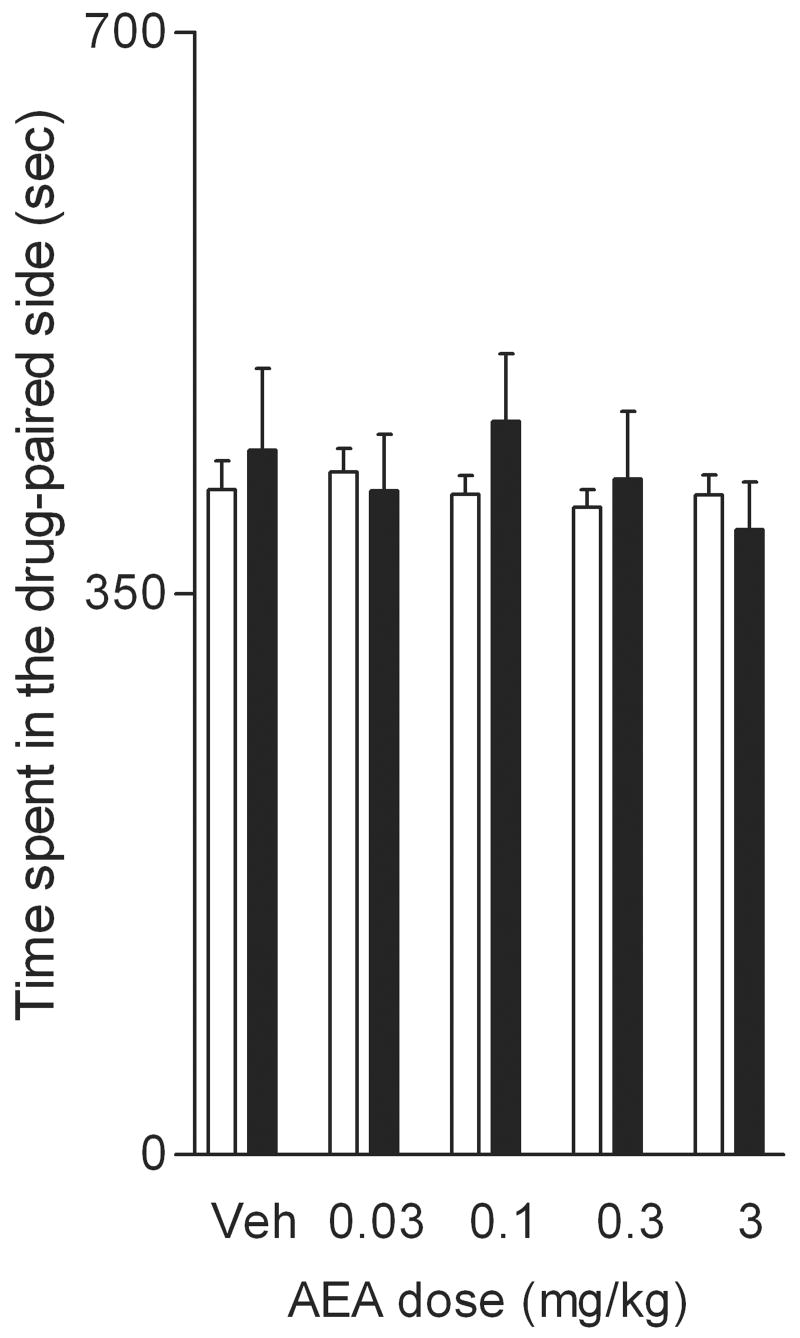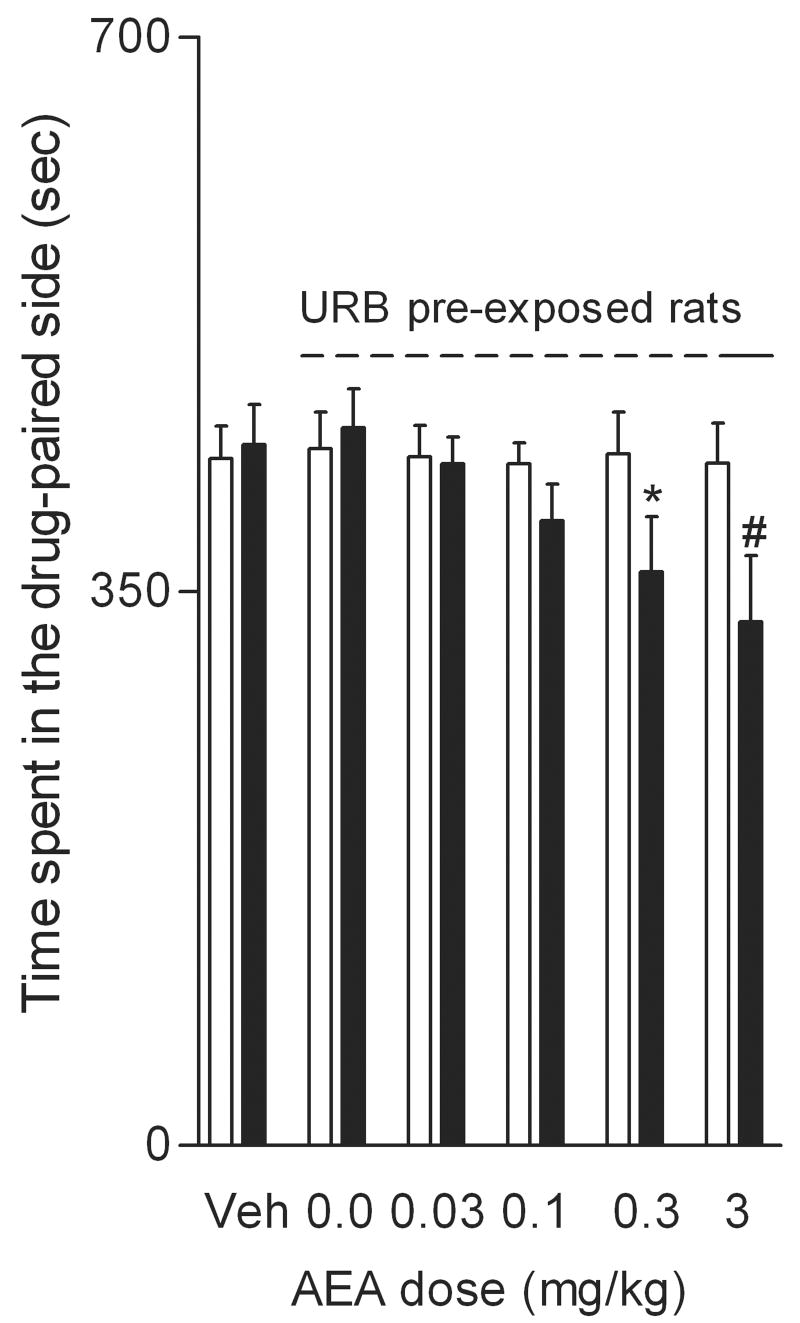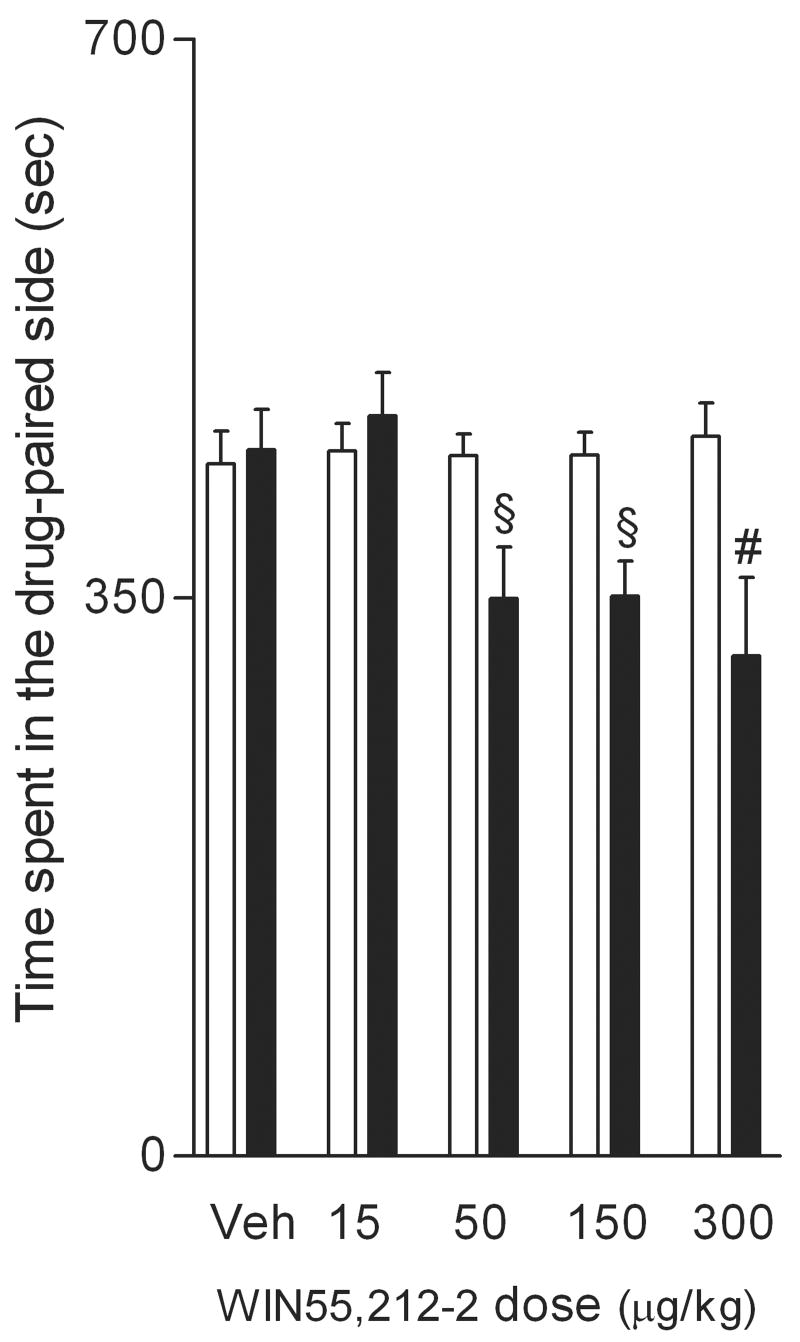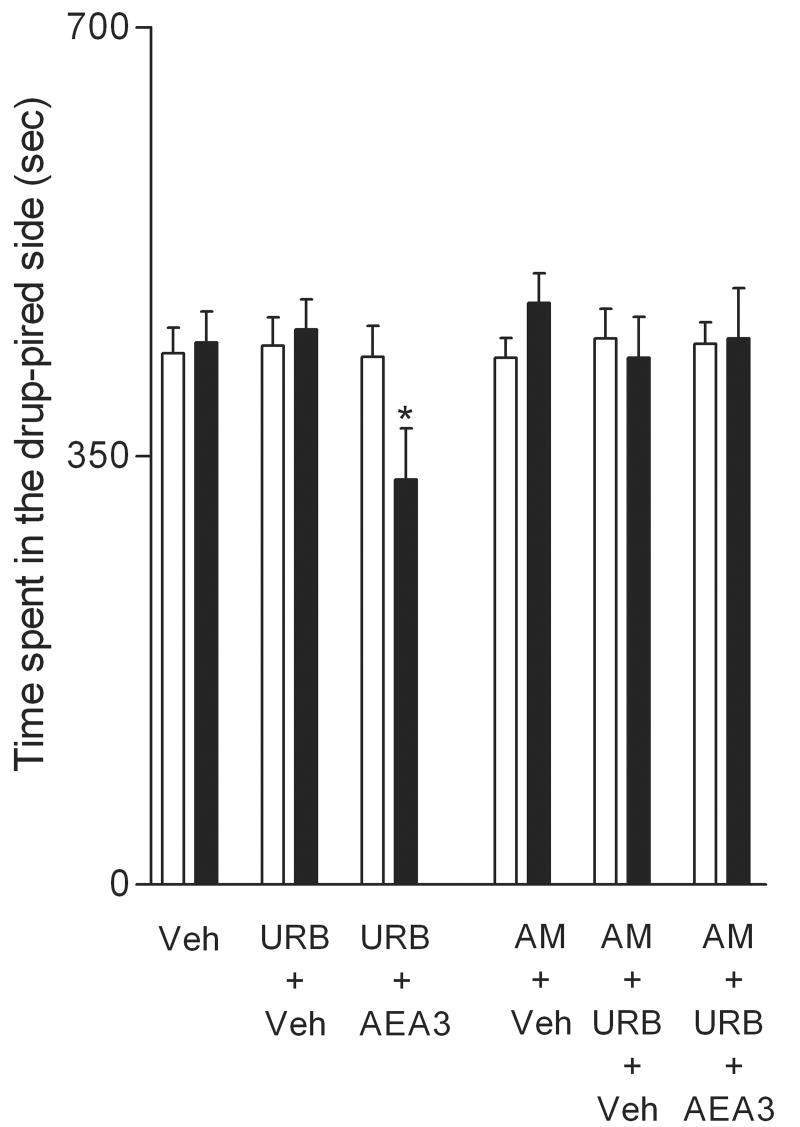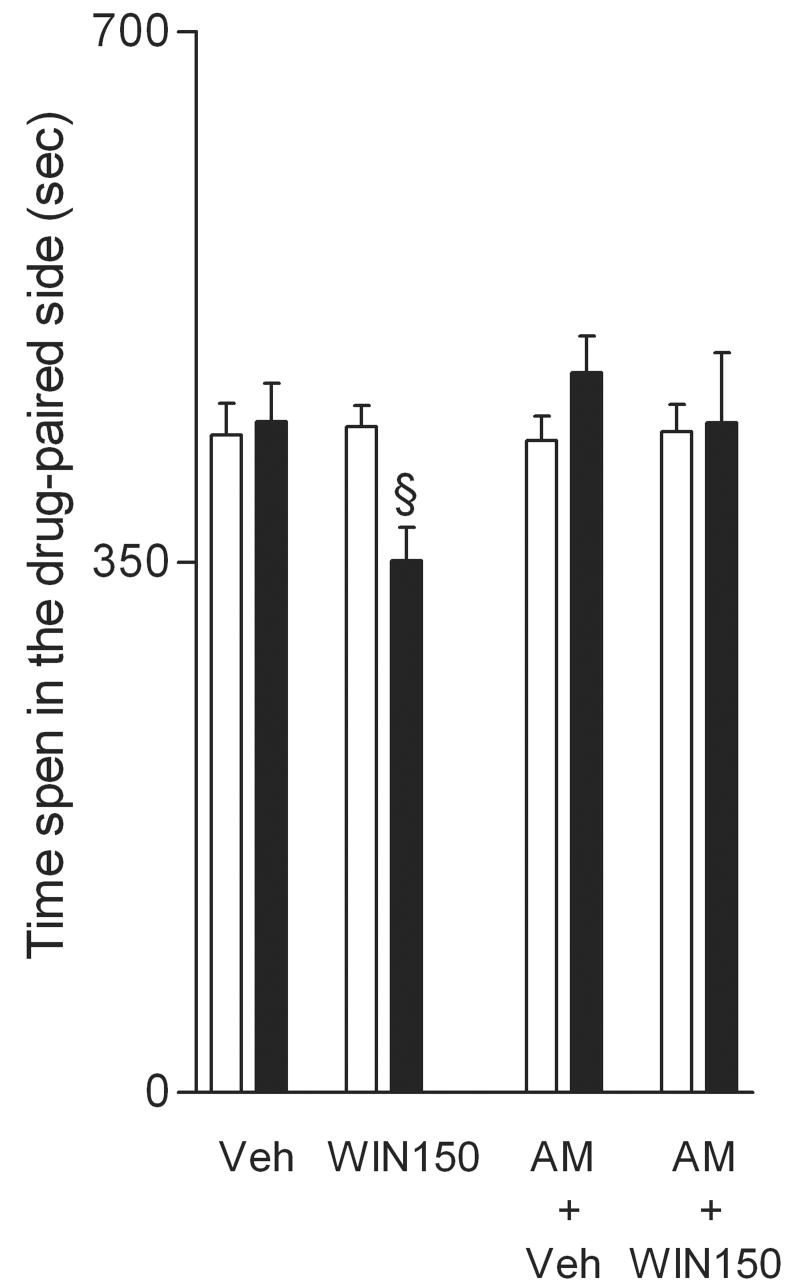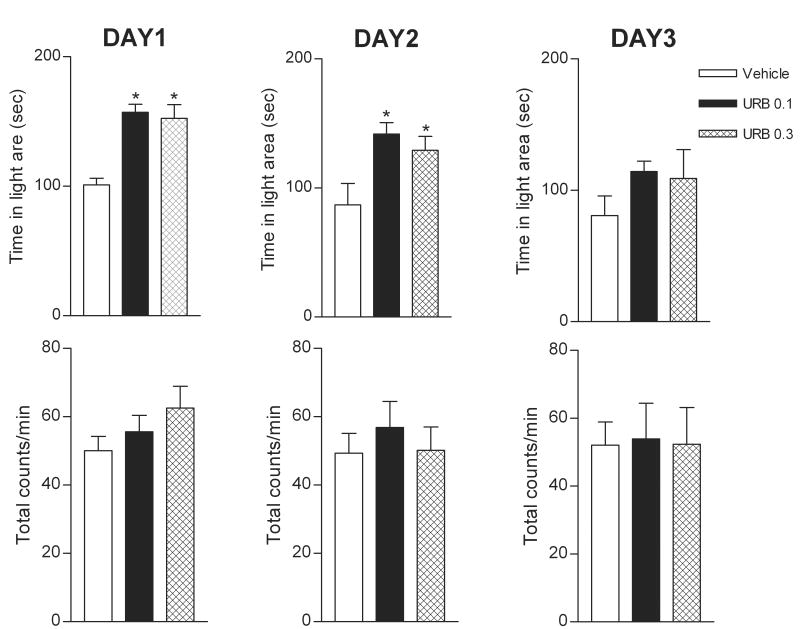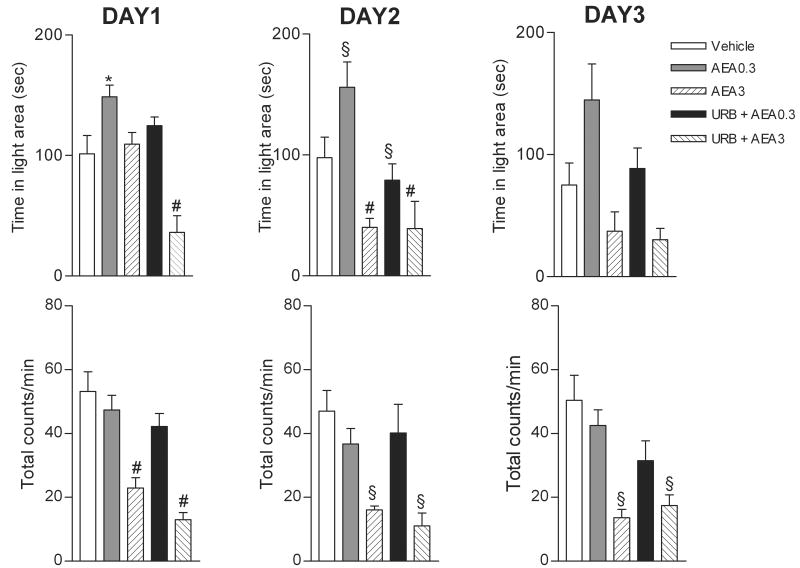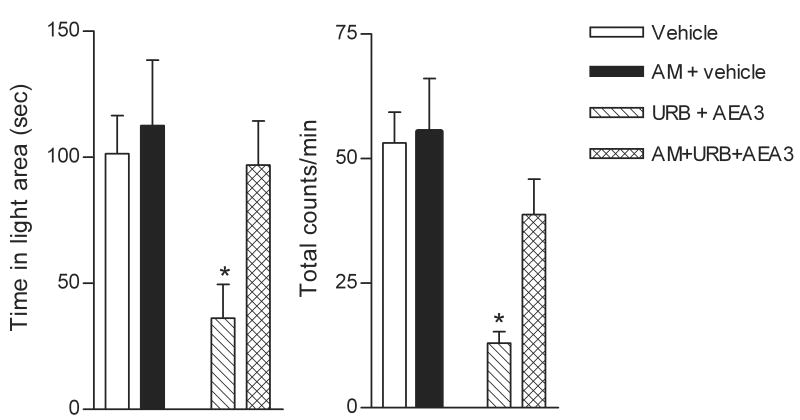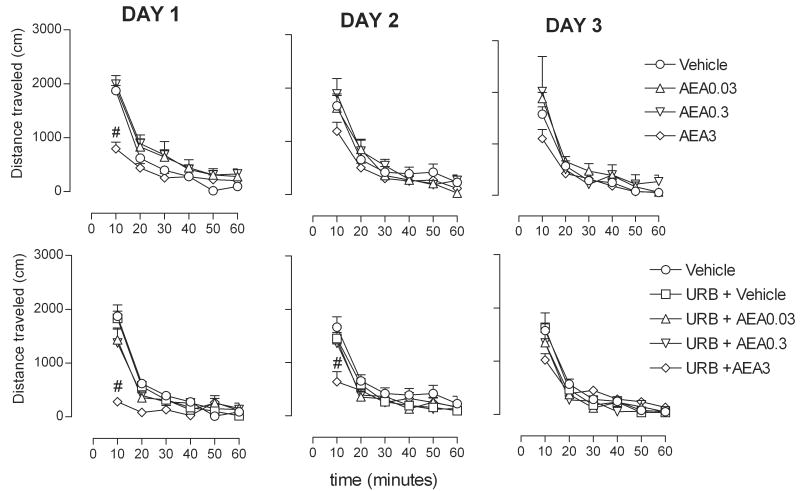Summary
Converging evidence suggests that the endocannabinoid system is an important constituent of neuronal substrates involved in brain reward processes and emotional responses to stress. Here, we evaluated motivational effects of intravenously administered anandamide, an endogenous ligand for cannabinoid-CB1 receptors, in Sprague-Dawley rats, using a place-conditioning procedure in which drugs abused by humans generally produce conditioned place preferences (reward). Anandamide (0.03 to 3mg/kg intravenous) produced neither conditioned place preferences nor aversions. However, when rats were pre-treated with the fatty-acid amide hydrolase (FAAH) inhibitor URB597 (cyclohexyl carbamic acid 3′-carbamoyl-3-yl ester; 0.3 mg/kg intraperitoneal), which blocks anandamide's metabolic degradation, anandamide produced dose-related conditioned place aversions. In contrast, URB597 alone showed no motivational effects. Like URB597 plus anandamide, the synthetic CB1-receptor ligand WIN 55,212-2 (50 to 300 μg/kg, intravenous) produced dose-related conditioned place aversions. When anxiety-related effects of anandamide and URB597 were evaluated in a light-dark box, both a low anandamide dose (0.3 mg/kg) and URB597 (0.1 and 0.3 mg/kg) produced anxiolytic effects when given alone, but produced anxiogenic effects when combined. A higher dose of anandamide (3 mg/kg) produced anxiogenic effects and depressed locomotor activity when given alone and these effects were potentiated after URB597 treatment. Finally, anxiogenic effects of anandamide plus URB597 and development of place aversions with URB597 plus anandamide were prevented by the CB1-receptor antagonist AM251 (3 mg/kg intraperitoneal). Thus, additive interactions between the effects of anandamide on brain reward processes and on anxiety may account for its aversive effects when intravenously administered during FAAH inhibition with URB597.
Keywords: Endogenous cannabinoids; anandamide; FAAH; URB597; WIN 55,212-2; conditioned place preferences; anxiety; locomotor activity; rats
Introduction
Converging evidence indicates that the endocannabinoid system is an important constituent of neuronal substrates involved in brain reward processes (Tanda et al., 1997, 2000; Ledent et al., 1999; Justinova et al., 2005b; Solinas et al., 2006) and emotional responses to stress (for review see: Valverde, 2005). However, little is known about direct effects of endogenous ligands for cannabinoid receptors on brain reward processes and emotional responses to stress. Anandamide (N-arachidonylethanolamide) was the first identified endogenous ligand for brain cannabinoid receptors (Devane et al., 1992). It is produced upon demand through activity-dependent cleavage of membrane lipid precursors, and is released from cells immediately after its production. After release, anandamide is rapidly eliminated through a two-step process involving transport into cells followed by intracellular hydrolysis to arachidonic acid and ethanolamide, catalyzed by fatty-acid amide hydrolase (FAAH) (for review see: Piomelli, 2003). This rapid inactivation of anandamide has made study of its in-vivo behavioral and neurochemical effects difficult. However, selective inhibitors of FAAH, such as URB597 (cyclohexyl carbamic acid 3′-carbamoyl-3-yl ester) have recently been developed which can be used to magnify and prolong the effects of both endogenously released and exogenously administered anandamide (Kathuria et al., 2003; Lichtman et al., 2004; Mor et al., 2004; Fegley et al., 2005).
To date, there are only a few studies showing that endogenous cannabinoids such as anandamide interact and participate in the neuronal circuitry that signals rewarding events and controls emotional responses to stress. We recently demonstrated that intravenously-administered anandamide is an effective reinforcer of drug-taking behavior in squirrel monkeys (Justinova et al., 2005b) and produces THC-like discriminative effects in rats that are potentiated after FAAH inhibition by URB597 (Solinas et al., 2007). These effects of anandamide were blocked by the CB1-receptor antagonist rimonabant (SR141716). They were obtained with intravenous injection of anandamide, a route of administration that results in a more rapid onset and greater magnitude of effects than the more commonly used intraperitoneal route of administration (Smith et al., 1994). Intravenously-administered anandamide also produces a rapid, short-lasting increase in extracellular levels of dopamine (DA) in the nucleus accumbens shell of rats, which is magnified and prolonged by URB597 and blocked by rimonabant and is a neurobiological marker of most drugs abused by humans (Solinas et al., 2006).
In this study, we first investigated the effects of intravenously-administered anandamide with a place-conditioning paradigm, a procedure widely used in rodents to assess drug effects related to reward or aversion, that can be used to explore motivational brain reward processes related to drugs abused by humans (Mucha et al., 1982; Schechter and Calcagnetti, 1993; Tzschentke, 1998). Since anandamide is rapidly inactivated by FAAH enzymes, we also investigated the effects of intravenous anandamide after FAAH inhibition by URB597. For comparison, we examined the motivational effects of intravenous administration of the synthetic CB1-receptor agonist WIN 55,212-2 with the same place-conditioning procedure. In addition, we attempted to reverse any effects obtained in the place-conditioning experiments with AM251, a selective CB1-receptor antagonist (an analog of rimonabant with greater selectivity for CB1 over CB2 receptors; Gatley et al., 1996, 1997).
It is known that the endocannabinoid system plays a modulatory role in emotional states such as anxiety and fear (Viveros et al., 2005). Several studies utilizing rodent models of anxiety or depression showed that FAAH inhibition produced anxiolytic-like effects (Kathuria et al., 2003; Patel and Hillard, 2006) and anti-depressant-like effects (Gobbi et al., 2005) in rats and mice, although these effects are not always found (Naidu et al., 2007). Also, the intra-dorsolateral periaqueductal injection of low dose of anandamide has been reported to produce anxiolytic-like effects when assessed with the elevated plus-maze (Moreira et al., 2007). Consequently, in separate groups of animals, we next investigated the effects of intravenously-administered anandamide alone and after FAAH inhibition by URB597 on anxiety-like responses at doses and combinations employed in the place-conditioning experiments. We used a light/dark test, a paradigm based on the innate aversion of rodents to brightly illuminated areas and on the spontaneous exploratory behavior of rodents in response to mild stressors, that is, novel environment and light (Crawley and Goodwin, 1980). Finally, to control for motor disturbances that anandamide or URB597 might induce, which could influence effects in the place-conditioning and light/dark box experiments, we investigated the effects of anandamide and URB597, alone and in combination, on spontaneous locomotor activity in an open-field test.
Methods
Animals
Subjects were Male Sprague-Dawley rats (Charles River Laboratories, Inc., Wilmington, MA) weighing 300-325g at the beginning of the experiments. They were individually housed in a temperature- and humidity-controlled room on a 12-h light/dark cycle. Experiments were conducted during the light phase. Food and water were available ad libitum and each animal was adapted to daily handling for one week before the start of experiments. Animals used in this study were maintained in facilities fully accredited by the American Association for the Accreditation of Laboratory Animal Care (AAALAC) and all experimentation was conducted in accordance with the guidelines of the Institutional Care and Use Committee of the Intramural Research Program, National Institute on Drug Abuse, NIH, and the Guide for Care and Use of Laboratory Animals (National Research Council 2003). All efforts were made to minimize animal suffering, to reduce the number of animals used, and to utilize alternatives to in vivo techniques, if available.
Surgical procedure
After acclimatization rats were anesthetized with an intraperitoneal (i.p.) injection of Equithesin (0.3 ml/100g) and under sterile conditions implanted with silastic catheters inserted into the right external jugular vein, as described previously (Solinas et al., 2003). Each rat was allowed to recover for approximately 1 week before the start of any experimental session.
Drugs
Anandamide and AM251 were synthesized by Dr. Alexandros Makriyannis (University of Connecticut, Centre for Drug Discovery and Departments of Pharmaceutical Sciences and Molecular Cell Biology, Storrs, Connecticut USA and Northeastern University, Centre for Drug Discovery, Boston, MA, USA). WIN 55,121-22 was purchased from Sigma/RBI (St. Louis, MO, USA). URB597 was synthesized (Mor et al., 2004) at the Department of Pharmacology, University of California, Irvine, CA, USA. Drugs were dissolved in a vehicle containing Tween 80 2%, ethanol 2%, and saline 96% and were injected in a volume of 1.0 ml/kg either i.v. or i.p., with the exception of URB597, which was dissolved in a vehicle containing 50% dimethylsulfoxide (DMSO) in saline and injected i.p.. Each experiment was done in a separate group of animals.
Behavioral Procedures
Place conditioning procedure
Apparatus
Locomotor activity boxes (Med Associates, St Albans, Vt., USA) were enclosed in sound-attenuation chambers (BRS/LVE, Laurel, Md., USA) with two boxes in each chest. A standard two-compartment place-preference insert (Med Associates) was situated inside each locomotor activity box. The two sides of the apparatus were differentiated by their floor type (mesh versus bar) and a small light was added on the wall of the sound-attenuation chambers on the side with the mesh floor, to increase the difference between the two sides. The illumination in the side with the mesh floor was approximately 1.3 lux. Each activity monitor consisted of a 16×16 infrared photocell detector array. These detectors measured the animal's position (left versus right side) and a computer tabulated time spent per side. Thus, time spent in one compartment could be deducted from the time spent in the other compartment (sum of both equaled 900 s). Before starting the experiment, each animal was randomly assigned to one of several different treatment groups (n= 9-11/group).
Experimental procedure
The general procedure consisted of three consecutive phases:
-pre-test
Rats were placed at the intersection of the two compartments with the guillotine door separating the two compartments raised and were allowed to explore both sides for 15 min. Time spent by the animal in each of the two compartments was recorded to monitor any initial preference for one side versus the other side. Animals showing a pronounced unconditioned preference for one compartment (more than 600 sec spent in one compartment) were excluded from the subsequent (conditioning) phase of the experiment.
-conditioning
Conditioning sessions were conducted over 3 consecutive days, with two sessions per day, using an ‘unbiased’ stimulus assignment procedure previously described (Le Foll et al., 2006). In the morning all rats received an i.v. injection of saline before being placed in one of the two compartments for 20 min, with the door separating the two compartments closed. Four hr later, the rats received an i.v. injection of anandamide (0.03 to 3mg/kg) or WIN 55,212-2 (15 to 300 μg/kg) or vehicle (Tween 80 2%, ethanol 2%, and saline 96%) and were placed in the opposite compartment for 20 min. URB597 (0.3mg/kg) was injected i.p., in the home cage, 40 min before vehicle or anandamide injection. For antagonism studies, AM251 (3mg/kg, i.p.) was co-administered with URB597 40 min before i.v. injection of vehicle or anandamide, or was administered alone 40 min before i.v. injection of vehicle or WIN 55,212-2. Drug-texture pairings were always counterbalanced.
-test
The day after the last conditioning session, a test session was conducted in which the animals did not receive any drug or vehicle treatment. During the test session, the door separating the two compartments was raised and the animals were placed at the intersection of the two compartments with access to both. Time spent by the animal in each of the compartments during a 15-min period was recorded.
Light/dark test
Apparatus
Four clear acrylic shuttle boxes (MED-Associates, model ENV-010MC) were individually enclosed in sound-attenuation chambers in a darkened room illuminated only by the screen of the computer. Shuttle boxes measured 40 × 16 × 21 cm and had an opaque black wall (2.5 cm thick) with a doorway (measuring 9 × 12 cm) between the compartments, such that the light compartment was 20 cm long and the dark compartment was 17.5 cm long. One compartment was lit by a bulb (100 mA, 28 V) covered by a white lens on the center of the wall at the far end of the compartment, 14.5 cm above the floor. The other compartment was unlit and had an opaque black covering around the outside of the box. The illumination (measured with a Sekonic light meter, model L308-B) was approximately 172 lux in the light side (in the centre) and approximately 5 lux in the dark side (facing the doorway). Each compartment had four photobeams spaced 5 cm apart, starting 5 cm from the center of the box.
Experimental procedure
On the day of the test, rats were transported to the darkened testing room and left in their home cages for 1 hr. Vehicle (Tween 80 2%, ethanol 2%, and saline 96%) or anandamide was administered i.v. immediately before testing. URB597 was injected i.p. in the home cage, 40 min before i.v. injection of vehicle or anandamide. Anxiety-like responses were recorded during three consecutive single daily sessions (DAYS 1-3). For antagonism studies, AM251 (3mg/kg i.p.) was co-administered with URB597 40 min before i.v. injection of anandamide or was administered alone 40 min before testing and anxiety-like responses were recorded during a single daily session. To start each session, a rat was placed in the light compartment, facing the corner of the wall with the light. During the 5-min test, total time spent (in sec.) and level of activity (in counts/min) in the light compartment was measured. Entry into a compartment, for purposes of measuring time spent in the compartment, was defined as the placement of all four paws in the compartment.
Spontaneous motor activity in the open field
Apparatus
Locomotor-activity boxes (Med Associates, East Fairfield, VT, USA) were enclosed in sound-attenuation chambers, with two boxes in each chamber. A small light was added on the wall of the sound-attenuation chambers and the illumination was approximately 2.6 lux. The boxes (41 × 41 × 32 cm) were composed of clear acrylic and had sawdust bedding on the floor. Activity was measured with a 16 × 16 array of photobeams. Med Associates Open Field Activity Software recorded the distance traveled during the session.
Experimental procedure
Motor activity was measured in animals not habituated to the activity boxes during 60-min sessions. Locomotor activity was recorded during three consecutive single daily sessions (DAYS 1-3). At the beginning of each session, rats were placed in the centre of the testing box. Anandamide or vehicle (Tween 80 2%, ethanol 2%, and saline 96%) was administered i.v. immediately before placement of the animal in the activity box. URB597 was injected i.p. in the home cage, 40 min before vehicle or anandamide injection. Before starting the experiment, each animal was randomly assigned to one of different treatment groups (n= 6-7/group).
Statistical analysis
All results are presented as group means (±SEM). The place conditioning data were analyzed by one-way analysis of variance (ANOVA) for repeated measures. Data from the light/dark test were analyzed by one-way analysis of variance (ANOVA). The locomotor-activity data were analyzed using repeated measures three-way analysis of variance (ANOVA), with URB597 pre-treatment, anandamide treatment and time as factors. Post-hoc comparisons, when appropriate, were performed by Newman-Keuls multiple comparisons test or by Tukey's multiple comparisons test. In all cases, differences with a P<0.05 were considered significant.
Results
Place conditioning study
No significant baseline differences were found between the time spent by the different groups of rats in the two compartments of the place-conditioning apparatus during the pre-conditioning session before conditioning sessions were started.
Effects of anandamide on place conditioning
Administration of different doses of anandamide (0.03 to 3 mg/kg i.v.) did not produce any significant change in time spent in the drug-paired compartment in the test session compared to the pre-test session [F9,81=1.41, P=ns, ANOVA] (Fig.1).
Fig.1.
Effects of anandamide on time spent in sec (means ± SEM n=9-11) in the drug-paired compartment during the 15-min pre-test session (open-bars) and the 15-min test session (closed-bars). Data were analyzed by one-way ANOVA for repeated measures between subjects. Anandamide (AEA) alone (0.03 to 3mg/kg) produced no significant conditioned place preferences or aversions (P=ns).
Effects of anandamide on place conditioning when given after FAAH inhibition by URB597
Significant treatment effects were found between subjects when time in the drug-paired compartment during the test and pre-test sessions was compared [F11,88=14.61, P<0.0001, ANOVA] (Fig.2). Post hoc analysis showed that when 0.3 or 3.0 mg/kg doses of anandamide were given during FAAH inhibition by URB597 (0.3 mg/kg), they produced significant decreases in time spent in the drug-paired compartment during the test session when compared with that in the pre-test session and with time spent by the vehicle group or URB plus vehicle group during the test session (P<0.05 and P<0.001, respectively). Post hoc analysis also showed that when URB597 was administered before anandamide vehicle it did not affect time spent in the drug-paired compartment in the test session when compared with that in the pre-test session or with time spent by the vehicle group during the test session (P>0.05) (Fig.2)
Fig.2.
Effects of anandamide after FAAH inhibition by 0.3mg/kg URB597 on time spent in sec (means ± SEM n=9-11) in the drug-paired compartment during the 15-min pre-test session (open-bars) and the 15-min test session (closed-bars). Data were analyzed by one-way ANOVA for repeated measures between subjects. Both the 0.3 and 3mg/kg doses of anandamide (AEA) induced significant conditioned place aversions. (*, P<0.05 and # P< 0.001 as compared with corresponding pre-test and with the vehicle or URB597 + vehicle test; Newman-Keuls multiple comparisions test).
Effects of WIN55,212-2 on place conditioning
As shown in Fig. 3, significant treatment effects were found between groups of rats when comparing the time spent in the drug-paired compartment before and after conditioning [F9,72=16.01, P<0.0001, ANOVA]. Post-hoc analysis showed that WIN55,212-2, at doses of 50, 150 and 300 μg/kg, produced significant and dose-related decreases in time spent in the drug-paired compartment during the test session when compared with either time spent in that compartment in the pre-test session or with time spent in that compartment by the vehicle group during the test session (P<0.01 and P<0.001, respectively).
Fig. 3.
Effects of WIN 55-212,2 on time spent in sec (means ± SEM n=9-11) in the drug-paired compartment during the 15-min pretest session (open-bars) and the 15-min test session (closed-bars). Data were analyzed by one-way ANOVA for repeated measures. WIN55-212.2, at doses of 50, 150 and 300 μg/kg, induced significant conditioned place aversions. (§ P< 0.01 and # P< 0.001, as compared with corresponding pre-test and with the vehicle test; Newman-Keuls multiple comparison test).
Effects of cannabinoid CB1-receptor blockade on the development of conditioned place aversions with anandamide after FAAH inhibition and with WIN 55,212-2
When 3mg/kg of the CB1 antagonist AM251 was given to rats treated with either 0.3 mg/kg URB597 followed by 3 mg/kg anandamide or with 150 μg/kg WIN 55,212-2, both of which produced significant conditioned place aversions, ANOVA for repeated measures showed significant treatment effects between groups of rats when comparing the time spent in the drug-paired compartment before and after conditioning sessions [F11,88=4.510, P<0.0001 and F7,56=11.72, P<0.0001, respectively]. Post hoc analysis showed that AM251 prevented the development of conditioned place aversions induced by URB plus anandamide (P<0.05) and by WIN55,212-2 (P<0.01) (Figs. 4 and 5). Post hoc analysis also showed that AM251 administered before vehicle it did not affect time spent in the drug-paired compartment in the test session when compared with that in the pre-test session or with time spent by the vehicle group during the test session (P>0.05) (Fig.4 and 5).
Fig.4.
Effects of CB1 blockade on the development of conditioned place aversions induced by anandamide after FAAH inhibiton by URB597. Time spent in sec (means ± SEM n=9-11) in the drug-paired compartment during the 15-min pre-test session (open-bars) and the 15-min test session (closed-bars) is shown. Data were analyzed by one-way ANOVA for repeated measures between subjects. 3 mg/kg of AM251 (AM) significantly blocked the development of the conditioned place aversions induced by 3 mg/kg of anandamide (AEA3) after FAAH inhibition by URB597 (URB). (*, P<0.05, as compared with AM+URB+AEA3 test; Newman-Keuls multiple comparison test).
Fig.5.
Effects of CB1 blockade on the development of conditioned place aversions induced by WIN 55,212-2. Time spent in sec (means ± SEM n=9-11) in the drug-paired compartment during the 15-min pretest session (open-bars) and the 15-min test session (closed-bars) is shown. Data were analyzed by one-way ANOVA for repeated measures between subjects. 3 mg/kg of AM251 (AM) significantly blocked the development of conditioned place aversions induced by 150μg/kg of WIN55-212,2 (WIN150) (§, P<0.01, as compared with AM3+WIN150 test, Newman-Keuls multiple comparisons test).
Light/dark test
Effects of URB597 on Anxiety-like behaviors
On test day 1 and 2, one-way ANOVA (between subjects) revealed a significant effect of URB597 treatment on the time spent in the light compartment [F2,15=7.52 P=0.0055; F2,14=5.485 P=0.0174 respectively] (Fig. 6, upper panel). Post hoc analysis showed that URB597 doses of 0.1 and 0.3 mg/kg significantly increased the time spent in the light compartment compared with vehicle treatment (P<0.05). On the third test day, the increase in time spent in the light compartment after 0.1 and 0.3 mg/kg URB597 was no longer significant. There was no significant effect of URB597 on level of activity during the three consecutive single daily test sessions (Fig. 6, lower panel).
Fig.6.
Effects of URB597 on anxiety-like behavior in the light/dark test. Rats received 0.1 or 0.3 mg/kg URB597 during three consecutive single daily sessions; (upper panel) time spent in the light compartment and (lower panel) level of activity (counts/min). Data represent the mean ± SEM (n= 5-6) and were analyzed by one-way ANOVA (* P<0.05 as compared with vehicle; Newman-Keuls multiple comparisons test).
Effects of anandamide on Anxiety-like behaviors
Fig. 7 shows the effects of anandamide, alone or in combination with URB597, in the light/dark test. On the first test day (DAY 1), one-way ANOVA (between subjects) revealed a significant effect of anandamide treatment on the time spent in the light compartment [F4,25= 13.36 P<0.0001] as well as on the level of activity [F4,25= 15.37 P<0.0001]. There was a significant increase in time spent (P< 0.05) in the light compartment after administration of the lower dose of 0.3mg/kg anandamide compared with vehicle, but this anxiolytic-like effect no longer occurred after FAAH inhibition by URB597 (Fig. 7, upper panel). There was no significant effect of 0.3 mg/kg anandamide on level of activity (Fig. 7, lower panel). In contrast, administration of the higher 3mg/kg dose of anandamide did not increase time in the light compartment and after FAAH inhibition it produced the opposite response, i.e., a marked and significant decrease in the time spent (P<0.001) in the light compartment (an anxiogenic-like effect). The 3mg/kg dose of anandamide produced significant decreases in the level of activity (P<0.001) both alone and after FAAH inhibition.
Fig.7.
Effects of anandamide (AEA), alone or in combination with URB597 0.3 mg/kg (URB), in the light/dark test. Rats received the drugs during three consecutive single daily sessions; (upper panel) time spent in the light compartment (sec) and (lower panel) level of activity (counts/min). Data represent the mean ± SEM (n=5-6) and were analyzed by one-way ANOVA (* P<0.05, § P<0.01, # P<0.001, as compared with vehicle and/or AEA0.3; Newman-Keuls multiple comparisons test;).
On the second test (DAY 2), one-way ANOVA (between subjects) also revealed a significant effect of anandamide treatment on time spent in the light compartment [F4,22= 8.923 P=0.0002], as well as on level of activity [F4,22= 8.15 P=0.0003]. There was a significant increase in time spent (P< 0.01) in the light compartment (an anxiolytic effect) after administration of the lower dose of 0.3mg/kg compared with vehicle, but, when this dose of anandamide was given after FAAH inhibition by URB597, there was no longer a significant effect compared to vehicle (Fig. 7, upper panel) and there was a significant decrease in time in the light compartment compared to 0.3 mg/kg anandamide alone (P<0.01). There was no significant effect of 0.3 mg/kg anandamide on the level of activity alone or after FAAH inhibition (Fig. 7, lower panel). Administration of the higher dose of 3mg/kg of anandamide, both alone and after FAAH inhibition by URB597, produced marked and significant decreases in time spent in the light compartment (anxiogenic effects) compared to vehicle (P<0.001). The 3mg/kg dose of anandamide also produced significant decreases in the level of activity (P<0.001), both alone and after FAAH inhibition, as it had on the first day.
By the third day (DAY 3), there was still a significant effect of treatment on the time spent in the light compartment [F4,22=5.34 P=0.0037] and on the level of activity [F4,22=7.9 P=0.0004]. Post hoc analysis showed a significant decrease in the level of activity at the higher 3mg/kg dose of anandamide, both alone and after FAAH inhibition with URB597, compared to vehicle (p<0.01).
Effects of cannabinoid CB1-receptor blockade on the anxiogenic-like effect of anandamide after FAAH inhibition
A 3mg/kg dose of the CB1 antagonist AM251 had no significant effect on time spent in the light compartment or in levels of activity (Fig. 8). As before (Fig.7), rats given 3 mg/kg anandamide after FAAH inhibition by 0.3 mg/kg URB597 showed significant decreases in time spent in the light compartment (anxiogenic-like effect) and decreases in levels of activity (Fig. 8). When rats given 3 mg/kg anandamide after FAAH inhibition by URB597 were pre-treated with 3mg/kg of AM251, ANOVA for repeated measures showed significant treatment effects between groups of rats on time spent in the light compartment [F3.18= 3.78 P=0.028], as well as on level of activity [F3.18= 8.7 P=0.0010]. Post hoc analysis showed that AM251 fully reversed both the anxiogenic-like effects and the decreases in levels of activity that were produced by anandamide after FAAH inhibition with URB597 (P<0.05) (Fig.8)
Fig.8.
Effects of CB1-receptor blockade on the anxiogenic-like and activity-decreasing effects produced by i.v. injection of 3 mg/kg anandamide in the light dark test after FAAH inhibition by URB597; (left panel) time spent in the light compartment (sec) and (right panel) level of activity (counts/min). Note that rats used for these CB1-receptor blockade experiments were experimentally naïve and these results represent a replication of findings with anandamide and URB597 shown in Fig. 7. Data shown represent the mean ± SEM (n= 5-6) and were analyzed by one-way ANOVA. 3 mg/kg of AM251 (AM) significantly blocked the anxiogenic-like effect produced by 3 mg/kg of anandamide (AEA3) after FAAH inhibition by 0.3 mg/kg URB597 (URB). (* P<0.05 as compared with AM+URB+AEA3; Newman-Keuls multiple comparisons test).
Locomotor activity in the open field
Fig. 9 shows the effects on locomotor activity of different doses of anandamide (AEA), given alone (upper panel) or in URB597 pre-exposed rats (lower panel) during three consecutive single daily sessions. On the first test day (DAY 1), three-way ANOVA showed a significant treatment-effect [F 3,44= 8.02 P=0.00022], a significant pre-treatment-effect [F 1,44= 15.4 P=0.00029], a significant time-effect [F 5,220= 221.6 P=0], a significant time × treatment interaction [F 15,220= 14.3 P< 0.0001] and a significant pre-treatment × time interaction [F 5,220= 4.4 P= 0.0007]. Post hoc analysis of data from the first 10 min after anandamide treatment showed a significant depression of locomotor activity in the 3mg/kg anandamide group and the URB597 plus 3mg/kg anandamide groups compared to the corresponding time-point for the other groups (P<0.001).
Fig.9.
Time course for effects of anandamide (AEA) alone (a) and after pre-treatment with URB597 0.3mg/kg i.p. (b) on locomotor activity. Mean (± SEM n=6-7) distance traveled (cm) during each of three consecutive single daily sessions. Each session lasted 1h, and data are analyzed in 10-min blocks. Data were analyzed by three-way ANOVA for repeated measures. (#, P<0.001 as compared to the corresponding time-point of the other groups; Tukey's comparisons test)
On the second test day (DAY 2), three-way ANOVA showed a significant pre-treatment-effect [F 1,44= 7.18 P=0.01], a significant time-effect [F 5,220= 143.1 P=0], a significant time × treatment interaction [F 15,220= 3.3 P< 0.0001] and a significant pre-treatment × time interaction [F 5,220= 2.68 P= 0.02]. Post hoc analysis of data from the first 10 min after anandamide treatment showed a significant depression of locomotor activity in the URB597 plus 3mg/kg anandamide group, but not in the 3mg/kg anandamide alone group, compared to the vehicle and the URB597 plus vehicle groups (P<0.001).
On the third test day (DAY 3), three-way ANOVA showed only a significant time-effect [F 5,220= 147.7 P=0] and a significant time × treatment interaction [F 15,220= 2.46 P= 0.002].
Discussion
In the present study with Sprague-Dawley rats, the motivational effects of the endogenous cannabinoid receptor ligand anandamide in a place-conditioning procedure designed to measure rewarding or aversive effects of psychoactive drugs were compared with the emotional effects of anandamide in a light/dark box designed to measure anxiety. Intravenously administered anandamide, by itself, did not produce either conditioned place preferences or conditioned place aversions. However, when rats were pre-treated with the FAAH inhibitor URB597, which prevents intracellular inactivation of anandamide by FAAH and prolongs its behavioral and neurochemical effects (Katuria et al., 2003), anandamide produced dose-related conditioned place aversions. The synthetic CB1-receptor agonist WIN 55,212-2 also produced dose-related conditioned place aversions under the same experimental conditions. Doses of anandamide and the i.v. route of administration were chosen on the basis of our recent findings that i.v. anandamide produces THC-like discriminative-stimulus effects (Solinas et al., 2007) and produces dose-dependent increases in extracellular levels of dopamine in the nucleus accumbens shell (Solinas et al., 2006) in rats. Both effects are potentiated by FAAH inhibition with URB597. The aversive effects of anandamide during FAAH inhibition and of WIN 55,212-2 in the present study appeared to be mediated mainly by cannabinoid CB1 receptors, since pre-treatment with the cannabinoid CB1 receptor antagonist AM251 (Gatley et al, 1996; 1997) blocked the development of the conditioned place aversions induced by these drugs. Consistent with previous findings by Gobbi et al. (2005), URB597 by itself, at a dose (0.3 mg/kg) that produces almost complete inhibition of FAAH activity, did not produce either conditioned place preferences or conditioned place aversions.
In contrast to the present findings with anandamide during FAAH inhibition, no conditioned place aversions were found by Mallet and Beninger (1998) when they used an i.p., rather than an i.v., route of administration with anandamide in rats pre-treated with phenylmethylsulfonil fluoride, another potent, but not selective, FAAH inhibitor. Although procedural differences could be responsible for this discrepancy, it is more likely that, when injected i.p., anandamide availability is not sufficient to produce effects in the place preference procedure because of hepatic first-passage metabolism, which does not favor rapid entry of anandamide into the brain, together with likely higher peak blood concentrations of anandamide after i.v. injection. For example, we have recently demonstrated that high doses of anandamide can produce THC-like discriminative effects when injected i.v. but not when injected i.p. in rats (Solinas et al., 2007).
When administered i.v., anandamide shares several physiological and behavioral characteristics with other drugs of abuse. Intravenous anandamide activates dopaminergic transmission in the mesolimbic system, resulting in increased extracellular levels of dopamine in the shell of the nucleus accumbens of rats and this effect of anandamide is dramatically increased in magnitude and prolonged by FAAH inhibition with URB597 (Solinas et al., 2006). Also, i.v. anandamide is self-administered by a non-human primate, the squirrel monkey, with levels of drug-taking behavior higher than vehicle and comparable to those maintained by i.v. injections of either cocaine or Δ9-tetrahydrocannabinol (THC) under similar conditions (Justinova et al., 2005b). Further, after FAAH inhibition with URB597, anandamide produces dose-dependent THC-like discriminative-stimulus effects in rats trained to discriminate i.p. injections of THC from i.p. injections of vehicle (Solinas, et al., 2007). In spite of its abilities to increase extracellular dopamine levels in the shell of the nucleus accumbens and to produce THC-like discriminative effects in rats, i.v. anandamide did not induce conditioned place preferences in rats under our experimental conditions. It should be noted, that the synthetic CB1 receptor agonist WIN 55-212-2 also increases extracellular dopamine levels in the nucleus accumbens shell (Tanda et al., 1997) and produces THC-like discriminative effects in rats (Gobbi et al., 2005), but it did not induce conditioned place preferences in rodents in the present experiments or in previous experiments by others (Chaperon et al., 1998), except under restricted conditions such as enriched environments (Bortolato et al., 2006).
In contrast to mice, cannabinoid CB1 receptor agonists usually produce anxiogenic-like effects in rats (Haller et al., 2007). One possible explanation for the aversive effects of WIN 55,212-2 and of i.v. anandamide after FAAH inhibition in rats with our place-conditioning procedure could be anxiogenic effects that mask the development of positive place preferences. In our light/dark experiments, we found that i.v. anandamide given alone and after FAAH inhibition produced marked and significant anxiogenic-like effects at doses (3 mg/kg anandamide; 0.3 mg/kg URB597 plus 0.3 mg/kg anandamide; 0.3 mg/kg URB597 plus 3 mg/kg anandamide) that increase extracellular levels of dopamine in the shell of the nucleus accumbens (Solinas et al., 2006). Pre-treatment with a 3 mg/kg dose of AM251 significantly and completely reversed the anxiogenic effects of the high 3mg/kg dose of anandamide given after FAAH inhibition, showing that this effect was mediated by CB1 receptors.
The anxiogenic-like effects of the high 3mg/kg dose of anandamide, when given alone on the second and third day of testing or when given after FAAH inhibition on all three days of testing, were accompanied by decreases in the levels of activity in the light compartment of the light/dark box for three consecutive days. The 3 mg/kg dose of anandamide produced a similar decrease in locomotor activity in the open-field test, but only during the first day when it was given alone and during the first and second day when it was given after FAAH inhibition with URB597. The differences in the profile of effects in the two testing situations could be due to the different levels of acitivity in the two situations or to conditioned associations that develop when measuring activity in an anxiogenic environment.
It is possible that aversive effects of anandamide given alone and after FAAH inhibition may diminish or disappear after a priming injection or after chronic exposure. This view is supported by findings of Valjent and Maldonado (2000) that THC induced conditioned place preferences only in mice that received a priming injection of THC before being exposed to the drug-paired conditioning chamber, a procedure that may have reduced or avoided the possible aversive effects of the drug during conditioning. Whether reversal of place preference effects would occur in rats pre-exposed to anandamide plus URB597 combinations before exposure to the drug-paired conditioning chamber, is an interesting question that remains to be studied.
In contrast to the results obtained when URB597 was combined with i.v. anandamide, URB597 alone produced dose-dependent anxiolytic effects in the light/dark experiments, replicating previous findings by Kathuria et al. in rats (2003) and Patel and Hillard in mice (2006). Interestingly, a low dose of anandamide (0.3mg/kg, i.v.), by itself, produced an anxiolytic effect similar to that observed with 0.1 and 0.3 mg/kg URB597, supporting the hypothesis that endogenous elevations in brain anandamide levels are responsible for the anxiolytic effects of URB597. Importantly, when given alone, neither URB597 nor the low 0.3mg/kg dose of anadamide affected levels of activity in the light/dark experiments or locomotor activity in the open-field experiments, indicating selective anxiolytic-like effects. Moreover, when given alone, neither URB597 (0.3 mg/kg) nor the low 0.3 mg/kg dose of anandamide produced rimonabant-sensitive (CB1-receptor mediated) increases in dopamine levels in the nucleus accumbens shell (Solinas et al., 2006).
The effects of URB597 and anandamide in the light/dark test indicate a bell-shaped dose-response curve, with small increases in anandamide levels (URB597 alone or the low 0.3 mg/kg dose of anandamide alone) inducing anxiolysis, and large increases in anandamide levels (URB597 plus a larger 3mg/kg dose of anandamide) inducing anxiety. It is possible that URB597 affects anandamide signaling around presynaptic membranes of cells expressing both CB1 and GABA receptors (hence the tolerance), while exogenously administered anandamide produces more widespread increases in anandamide signaling around CB1 receptors located there and at all other CB1-receptor locations in the brain, including presynaptic membranes of cells expressing both CB1 and glutamate receptors (Haller et al., 2007), resulting in the different effects when URB597 and the low dose of anandamide were given alone and when URB597 was given in combination with different doses of intravenously-administered anandamide. Thus, URB597 alone may primarily increase anandamide availability at GABAergic synapses resulting in anxyiolytic effects. Since GABAergic synapses are more sensitive to cannabinoid agonists than glutamatergic synapses, the low dose of anandamide may only have affected GABAergic synapses, again resulting in anxiolytic effects. However, when the low dose of anandamide was given after FAAH inhibition by URB597, availability of anandamide would increase and both GABAergic and glutamtergic synapses would be affected, resulting in the anxiolytic and anxiogenic effects counteracting each other. At the high dose of anandamide, CB1 receptors at glutamatergic synapses may be more strongly activated, resulting in the delayed appearance of anxiogenic effects on the second day of testing. Finally, when the high dose of anandamide was given after URB597, glutamatergic synapses may be fully activated and mild anxiolytic effects mediated by GABAergic synapses could be overwhelmed by strong anxiogenic effects mediated by glutamatergic synapses. Alternatively, the bell-shaped dose-response curve may be caused by interactions between the cannabinoid system and other systems, for example, vanilloid (Starowicz et al., 2007) or serotonergic (Braida et al., 2007) systems.
In place-conditioning studies, cannabinoid CB1-receptor agonists such as THC seldom produce conditioned place preferences, except at low doses and under special conditions (Lepore et al., 1995; Valjent and Maldonado, 2000; Braida et al., 2004; Le Foll et al., 2006), but higher doses of these drugs frequently produce dose-related conditioned place aversions (present experiments and Parker and Gilles, 1995; Mc Gregor et al., 1996; Saňudo-Peňa et al., 1997; Chaperon et al., 1998; Hutcheson et al., 1998). Environmental factors can influence responses in place-conditioning experiments with non-cannabinoid drugs such as amphetamine and kappa opioids (Bowling and Bardo, 1994; Smith et al., 2003) and environmental factors may also influence results with cannabinoids. For example, Bortolato et al. (2006) found that, in rats housed under enriched conditions, the putative anandamide uptake inhibitor AM404 (Beltramo et al., 1997) and the synthetic CB1-receptor agonist WIN55,212-2 both induced significant conditioned place preferences. Conversely, no place preferences or aversions were induced by AM404 or WIN55,212-2 in rats housed under normal non-enriched conditions. Thus, it is possible that in rats housed under enriched conditions, anandamide might induce conditioned place preferences rather than aversions in the presence of FAAH inhibition.
Concurrent exposure to other drugs may also influence responses in place-conditioning experiments with cannabinoids. For example, Le Foll and Goldberg (2006) reported a conditioned place preference at a low 0.1 mg/kg dose of THC and no conditioned preferences or aversions at higher 1 and 2 mg/kg THC doses in Sprague-Dawley rats. However, nicotine pre-exposed rats failed to develop conditioned place preferences with the low 0.1 mg/kg dose of THC and developed conditioned place aversions with higher 1 and 2 mg/kg doses of THC. These conditioned place aversions may reflect an increased sensitivity to cannabinoids after nicotine exposure.
Finally, significant differences have been reported between rat strains in the ability of cannabinoids to affect the threshold for intracranial self-stimulation (Lepore et al., 1996) and to support drug-taking and drug-seeking behavior (Deiana et al., 2006) and Sprague-Dawley rats have been reported to be insensitive to the positive reinforcing effects of WIN55,212-2 in intravenous self-administration experiments, unlike Long-Evans or Lister Hooded rats (Fattore et al., 2001; Deiana et al., 2006). However, Lecca et al. (2006) found positive reinforcing effects of WIN 55,212-2 in similar intravenous self-administration experiments in Sprague-Dawley rats.
In conclusion, activation of the endogenous cannabinoid system by i.v. anandamide has effects on motivation and anxiety that are revealed by fatty-acid amide hydrolase (FAAH) inhibition. Although intravenously administered anandamide and the FAAH inhibitor URB597, by themselves, had no motivational effects in the place-conditioning experiments, both URB597 and a low intravenous dose of anandamide had significant anxiolytic effects in the light/dark box experiments. When FAAH was inhibited by URB597, however, intravenously administered anandamide produced both dose-related anxiogenic effects and dose-related conditioned place aversions. Additive interactions between the effects of anandamide on motivational brain reward processes and on emotional responses to stress might account for its aversive effects when intravenously administered during FAAH inhibition with URB597.
Acknowledgments
This research was supported by the Intramural Research Program of the NIH, National Institute on Drug Abuse, Department of Health and Human Services, by NIH Grants DA09158, DA7215, DA12413, and DA12447, by the Institute of Experimental Medicine, Hungarian Academy of Sciences, and by the Italian Ministry of University and Scientific Research (MIUR) and the Centre of Excellence on ‘Neurobiology of Dependence’.
Footnotes
Publisher's Disclaimer: This is a PDF file of an unedited manuscript that has been accepted for publication. As a service to our customers we are providing this early version of the manuscript. The manuscript will undergo copyediting, typesetting, and review of the resulting proof before it is published in its final citable form. Please note that during the production process errors may be discovered which could affect the content, and all legal disclaimers that apply to the journal pertain.
References
- Beltramo M, Stella N, Calignano A, Lin SY, Makriyannis A, Piomelli D. Functional role of high-affinity anandamide transport, as revealed by selective inhibition. Science. 1997;277:1094–1097. doi: 10.1126/science.277.5329.1094. [DOI] [PubMed] [Google Scholar]
- Bortolato M, Campolongo P, Mangieri RA, Scattoni ML, Frau R, Trezza V, La Rana G, Russo R, Calignano A, Gessa GL, Cuomo V, Piomelli D. Anxiolytic-Like Properties of the Anandamide Transport Inhibitor AM404. Neuropsychopharmacology. 2006;31:2652–2659. doi: 10.1038/sj.npp.1301061. [DOI] [PubMed] [Google Scholar]
- Bowling SL, Bardo MT. Locomotor and rewarding effects of amphetamine in enriched, social, and isolate reared rats. Pharmacol Biochem Behav. 1994;48:459–464. doi: 10.1016/0091-3057(94)90553-3. [DOI] [PubMed] [Google Scholar]
- Braida D, Iosue S, Pegorini S, Sala M. Delta9-tetrahydrocannabinol-induced conditioned place preference and intracerebroventricular self-administration in rats. Eur J Pharmacol. 2004;506:63–69. doi: 10.1016/j.ejphar.2004.10.043. [DOI] [PubMed] [Google Scholar]
- Braida D, Limonta V, Malabarba L, Zani A, Sala M. 5-HT1A receptors are involved in the anxiolytic effect of Delta9-tetrahydrocannabinol and AM 404, the anandamide transport inhibitor, in Sprague-Dawley rats. Eur J Pharmacol. 2007 Jan 26;555(23):156–63. doi: 10.1016/j.ejphar.2006.10.038. [DOI] [PubMed] [Google Scholar]
- Chaperon F, Soubrie P, Puech AJ, Thiebot MH. Involvement of central cannabinoid (CB1) receptors in the establishment of place conditioning in rats. Psychopharmacology. 1998;135:324–332. doi: 10.1007/s002130050518. [DOI] [PubMed] [Google Scholar]
- Cheer JF, Kendall DA, Marsden CA. Cannabinoid receptors and reward in the rat: a conditioned place preference study. Psychopharmacology. 2000a;151:25–30. doi: 10.1007/s002130000481. [DOI] [PubMed] [Google Scholar]
- Crawley JN, Goodwin FK. Preliminary report of a simple animal behaviour for the anxiolytic effects of benzodiazepines. Pharmacol Biochem Behav. 1980;13:167–170. doi: 10.1016/0091-3057(80)90067-2. [DOI] [PubMed] [Google Scholar]
- Deiana S, Fattore L, Spano MS, Cossu G, Porcu E, Fadda P, Fratta W. Strain and schedule-dependent differences in the acquisition, maintenance and extinction of intravenous cannabinoid self-administration in rats. Neuropharmacology. 2007;52:646–654. doi: 10.1016/j.neuropharm.2006.09.007. [DOI] [PubMed] [Google Scholar]
- Devane WA, Hanus L, Breuer A, Pertwee RG, Stevenson LA, Griffin G, Gibson D, Mandelbaum A, Etinger A, Mechoulam R. Isolation and structure of a brain constituent that binds to the cannabinoid receptor. Science. 1992;258:1946–1949. doi: 10.1126/science.1470919. [DOI] [PubMed] [Google Scholar]
- Fattore L, Cossu G, Martellotta CM, Fratta W. Intravenous self-administration of the cannabinoid CB1 receptor agonist WIN 55,212-2 in rats. Psychopharmacology. 2001;156:410–416. doi: 10.1007/s002130100734. [DOI] [PubMed] [Google Scholar]
- Fegley D, Gaetani S, Duranti A, Tontini A, Mor M, Tarzia G, Piomelli D. Characterization of the fatty acid amide hydrolase inhibitor cyclohexyl carbamic acid 3′-carbamoyl-biphenyl-3-yl ester (URB597): effects on anandamide and oleoylethanolamide deactivation. J Pharmacol Exp Ther. 2005;313:352–358. doi: 10.1124/jpet.104.078980. [DOI] [PubMed] [Google Scholar]
- Gatley SJ, Gifford AN, Volkow ND, Lan R, Makriyannis A. 123I-labeled AM251: a radioiodinated ligand which binds in vivo to mouse brain cannabinoid CB1 receptors. Eur J Pharmacol. 1996;307:331–338. doi: 10.1016/0014-2999(96)00279-8. [DOI] [PubMed] [Google Scholar]
- Gatley SJ, Lan R, Pyatt B, Gifford AN, Volkow ND, Makriyannis A. Binding of the non-classical cannabinoid CP 55,940, and the diarylpyrazole AM251 to rodent brain cannabinoid receptors. Life Sci. 1997;61:191–197. doi: 10.1016/s0024-3205(97)00690-5. [DOI] [PubMed] [Google Scholar]
- Gobbi G, Bambico FR, Mangieri R, Bortolato M, Campolongo P, Solinas M, Cassano T, Morgese MG, Debonnel G, Duranti A, Tontini A, Tarzia G, Mor M, Trezza V, Goldberg SR, Cuomo V, Piomelli D. Antidepressant-like activity and modulation of brain monoaminergic transmission by blockade of anandamide hydrolysis. Proc Natl Acad Sci U S A. 2005;102:18620–18625. doi: 10.1073/pnas.0509591102. [DOI] [PMC free article] [PubMed] [Google Scholar]
- Haller J, Matyas F, Soproni K, Varga B, Barsy B, Nemeth B, Mikics E, Freund TF, Hajos N. Correlated species differences in the effects of cannabinoid ligands on anxiety and on GABAergic and glutamatergic synaptic transmission. Eur J Neurosci. 2007 Apr;25(8):2445–56. doi: 10.1111/j.1460-9568.2007.05476.x. [DOI] [PMC free article] [PubMed] [Google Scholar]
- Hutcheson DM, Tzavara ET, Smadja C, Valjent E, Roques BP, Hanoune J, Maldonado R. Behavioral and biochemical evidence for signs of abstinence in mice chronically treated with delta-9-tetrahydrocannabinol. Br J Pharmacol. 1998;125:1567–1577. doi: 10.1038/sj.bjp.0702228. [DOI] [PMC free article] [PubMed] [Google Scholar]
- Justinova Z, Solinas M, Tanda G, Redhi GH, Goldberg SR. The endogenous cannabinoid anandamide and its synthetic analog R(+)-methanandamide are intravenously self-administered by squirrel monkeys. J Neurosci. 2005;25:5645–5650. doi: 10.1523/JNEUROSCI.0951-05.2005. [DOI] [PMC free article] [PubMed] [Google Scholar]
- Kathuria S, Gaetani S, Fegley D, Valino F, Duranti A, Tontini A, Mor M, Tarzia G, La Rana G, Calignano A, Giustino A, Tattoli M, Palmery M, Cuomo V, Piomelli D. Modulation of anxiety through blockade of anandamide hydrolysis. Nat Med. 2003;9:76–81. doi: 10.1038/nm803. [DOI] [PubMed] [Google Scholar]
- Ledent C, Valverde O, Cossu G, Petitet F, Aubert JF, Beslot F, Bohme GA, Imperato A, Pedrazzini T, Roques BP, Vassart G, Fratta W, Parmentier M. Unresponsiveness to cannabinoids and reduced addictive effects of opiates in CB1 receptor knockout mice. Science. 1999;283:401–404. doi: 10.1126/science.283.5400.401. [DOI] [PubMed] [Google Scholar]
- Le Foll B, Wiggins M, Goldberg SR. Nicotine pre-exposure does not potentiate the locomotor or rewarding effects of Delta-9-tetrahydrocannabinol in rats. Behav Pharmacol. 2006;17:195–199. doi: 10.1097/01.fbp.0000197460.16516.81. [DOI] [PubMed] [Google Scholar]
- Lecca D, Cacciapaglia F, Valentini V, Di Chiara G. Monitoring extracellular dopamine in the rat nucleus accumbens shell and core during acquisition and maintenance of intravenous WIN 55,212-2 self-administration. Psychopharmacology. 2006;188:63–67. doi: 10.1007/s00213-006-0475-3. [DOI] [PubMed] [Google Scholar]
- Lepore M, Vorel SR, Lowinson J, Gardner EL. Conditioned place preference induced by Δ9-tetrahydrocannabinol: comparison with cocaine, morphine, and food reward. Life Sci. 1995;56:2073–2080. doi: 10.1016/0024-3205(95)00191-8. [DOI] [PubMed] [Google Scholar]
- Lepore M, Liu X, Savage V, Matalon D, Gardner EL. Genetic differences in delta 9-tetrahydrocannabinol-induced facilitation of brain stimulation reward as measured by a rate-frequency curve-shift electrical brain stimulation paradigm in three different rat strains. Life Sci. 1996;58:365–372. doi: 10.1016/0024-3205(96)00237-8. [DOI] [PubMed] [Google Scholar]
- Lichtman AH, Leung D, Shelton CC, Saghatelian A, Hardouin C, Boger DL. Reversible inhibitors of fatty acid amide hydrolase that promote analgesia: evidence for an unprecedented combination of potency and selectivity. J Pharmacol Exp Ther. 2004;311:441–448. doi: 10.1124/jpet.104.069401. [DOI] [PubMed] [Google Scholar]
- Mallet PE, Beninger RJ. Delta 9-tetrahydrocannabinol, but not the endogenous cannabinoid receptor ligand anandamide, produces conditioned place avoidance. Life Sci. 1998;62:2431–2439. doi: 10.1016/s0024-3205(98)00226-4. [DOI] [PubMed] [Google Scholar]
- McGregor IS, Issakidis CN, Prior G. Aversive effects of the synthetic cannabinoid CP 55,940 in rats. Pharmacol Biochem Behav. 1996;53:657–664. doi: 10.1016/0091-3057(95)02066-7. [DOI] [PubMed] [Google Scholar]
- Mor M, Rivara S, Lodola A, Plazzi PV, Tarzia G, Duranti A, Tontini A, Piersanti G, Kathuria S, Piomelli D. Cyclohexylcarbamic acid 3′- or 4′-substituted biphenyl-3-yl esters as fatty acid amide hydrolase inhibitors: synthesis, quantitative structure-activity relationships, and molecular modeling studies. J Med Chem. 2004;47:4998–5008. doi: 10.1021/jm031140x. [DOI] [PubMed] [Google Scholar]
- Moreira FA, Aguiar DC, Guimaraes FS. Anxiolytic-like effect of cannabinoids injected into the rat dorsolateral periaqueductal gray. Neuropharmacology. 2007 Mar;52(3):958–65. doi: 10.1016/j.neuropharm.2006.10.013. [DOI] [PubMed] [Google Scholar]
- Mucha RF, van der Kooy D, O'Shaughnessy M, Bucenieks P. Drug reinforcement studied by the use of place conditioning in rat. Brain Res. 1982;243:91–105. doi: 10.1016/0006-8993(82)91123-4. [DOI] [PubMed] [Google Scholar]
- Naidu PS, Varvel SA, Ahn K, Cravatt BA, Martin BR, Lichtman AH. Evaluation of fatty acid amide hydrolase inhibition in murine models of emotionality. Psychopharmacology (Berl) 2007;192:61–70. doi: 10.1007/s00213-006-0689-4. [DOI] [PubMed] [Google Scholar]
- Parker LA, Gillies T. THC-induced place and taste aversions in Lewis and Sprague-Dawley rats. Behav Neurosci. 1995;109:71–78. doi: 10.1037//0735-7044.109.1.71. [DOI] [PubMed] [Google Scholar]
- Patel S, Hillard CJ. Pharmacological evaluation of cannabinoid receptor ligands in a mouse model of anxiety: further evidence for an anxiolytic role for endogenous cannabinoid signaling. J Pharmacol Exp Ther. 2006;318:304–311. doi: 10.1124/jpet.106.101287. [DOI] [PubMed] [Google Scholar]
- Piomelli D. The molecular logic of endocannabinoid signalling. Nat Rev Neurosci. 2003;4:873–884. doi: 10.1038/nrn1247. [DOI] [PubMed] [Google Scholar]
- Sanudo-Pena MC, Tsou K, Delay ER, Hohman AG, Force M, Walker JM. Endogenous cannabinoids as an aversive or counter-rewarding system in the rat. Neurosci Lett. 1997;223:125–128. doi: 10.1016/s0304-3940(97)13424-3. [DOI] [PubMed] [Google Scholar]
- Schechter MD, Calcagnetti DJ. Continued trends in the conditioned place preference literature from 1992 to 1996, inclusive, with a cross-indexed bibliography. Neurosci Biobehav Rev. 1998;22:827–846. doi: 10.1016/s0149-7634(98)00012-8. [DOI] [PubMed] [Google Scholar]
- Smith PB, Compton DR, Welch SP, Razdan RK, Mechoulam R, Martin BR. The pharmacological activity of anandamide, a putative endogenous cannabinoid, in mice. J Pharmacol Exp Ther. 1994;270:219–227. [PubMed] [Google Scholar]
- Smith MA, Bryant PA, McClean JM. Social and environmental enrichment enhances sensitivity to the effects of kappa opioids: studies on antinociception, diuresis and conditioned place preference. Pharmacol Biochem Behav. 2003;76:93–101. doi: 10.1016/s0091-3057(03)00189-8. [DOI] [PubMed] [Google Scholar]
- Solinas M, Panlilio LV, Antoniou K, Pappas LA, Goldberg SR. The cannabinoid CB1 antagonist N-piperidinyl-5-(4-chlorophenyl)-1-(2,4-dichlorophenyl) -4-methylpyrazole-3-carboxamide (SR-141716A) differentially alters the reinforcing effects of heroin under continuous reinforcement, fixed ratio, and progressive ratio schedules of drug self-administration in rats. J Pharmacol Exp Ther. 2003;306:93–102. doi: 10.1124/jpet.102.047928. [DOI] [PubMed] [Google Scholar]
- Solinas M, Goldberg SR. Motivational effects of cannainoids and opioids on food reinforcement dependent on simultaneous activation of cannabinoid and opioid system. Neuropsycophrmacology. 2005b;30:2035–2045. doi: 10.1038/sj.npp.1300720. [DOI] [PubMed] [Google Scholar]
- Solinas M, Justinova Z, Goldberg SR, Tanda G. Anandamide administration alone and after inhibition of fatty acid amide hydrolase (FAAH) increases dopamine levels in the nucleus accumbens shell in rats. J Neurochem. 2006;98:408–419. doi: 10.1111/j.1471-4159.2006.03880.x. [DOI] [PubMed] [Google Scholar]
- Solinas M, Tanda G, Justinova Z, Wertheim CE, Yasar S, Piomelli D, Vadivel SK, Makriyannis A, Goldberg SR. The endogenous cannabinoid anandamide produces THC-like discriminative and neurochemical effects that are enhanced by inhibition of fatty acid amide hydrolase (FAAH) but not by inhibition of anandamide transport. J Pharmacol Exp Ther. 2007 doi: 10.1124/jpet.106.114124. Epub ahead of print. [DOI] [PubMed] [Google Scholar]
- Tanda G, Pontieri FE, Di Chiara G. Cannabinoid and heroin activation of mesolimbic dopamine transmission by a common mu1 opioid receptor mechanism. Science. 1997;276:2048–2050. doi: 10.1126/science.276.5321.2048. [DOI] [PubMed] [Google Scholar]
- Tanda G, Munzar P, Goldberg SR. Self-administration behavior is maintained by the psychoactive ingredient of marijuana in squirrel monkeys. Nat Neurosci. 2000;3:1073–1074. doi: 10.1038/80577. [DOI] [PubMed] [Google Scholar]
- Tzschentke TM. Measuring reward with the conditioned place preference paradigm: a comprehensive review of drug effects, recent progress and new issues. Prog Neurobiol. 1998;56:613–72. doi: 10.1016/s0301-0082(98)00060-4. [DOI] [PubMed] [Google Scholar]
- Valjent E, Maldonado R. A behavioural model to reveal place preference to delta 9-tetrahydrocannabinol in mice. Psychopharmacology (Berl) 2000;147:436–8. doi: 10.1007/s002130050013. [DOI] [PubMed] [Google Scholar]
- Valverde O. Participation of the cannabinoid system in the regulation of emotional-like behaviour. Curr Pharm Des. 2005;11(26):3421–9. doi: 10.2174/138161205774370780. Review. [DOI] [PubMed] [Google Scholar]
- Viveros MP, Marco EM, File SE. Endocannabinoid system and stress and anxiety responses. Pharmacol Biochem Behav. 2005 Jun;81(2):331–42. doi: 10.1016/j.pbb.2005.01.029. Review. [DOI] [PubMed] [Google Scholar]



